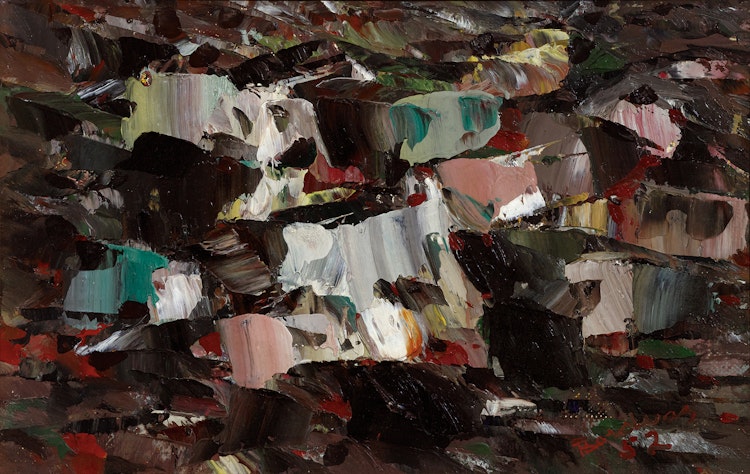La nuit se précise by Paul-Émile Borduas

Paul-Émile Borduas
La nuit se précise
oil on canvas
signed and dated 1952 lower right
7.75 x 12 ins ( 19.7 x 30.5 cms )
Auction Estimate: $60,000.00 - $80,000.00
Price Realized $72,000.00
Sale date: December 6th 2023
Acquired directly from the Artist by Gérard Lortie, Montreal
Fred S. Mendel, Saskatchewan
Gift to Miriam Shields, Saskatchewan
By descent to a Private Collection, Calgary
Heffel Fine Art, auction, Vancouver, 7 May 2012, lot 10
Private Collection, Calgary
“Dernière exposition...des derniers tableaux”, Saint–Hilaire Studio, 26–27 April 1952, no. 10
“Exposition de tableaux et d’encres”, Foyer de l’art et du livre, Ottawa, 10–20 October 1952, no. 9
François–Marc Gagnon, “Paul-Émile Borduas: Life & Work” [online publication], Art Canada Institute, Toronto, 2014, page 56
Borduas’ work from 1951 and 1952, following the aftermath of the publication of “Refus Global”, and just prior to moving to New York City, reveals a shift away from Automatism to a more personal form of Abstract Expressionism. The distinction between object and ground becomes blurred, and a central focal point disappears in favour of a flattened, ‘all–over’ pictorial surface. Art historian François–Marc Gagnon remarks on the developments during these important years of Borduas’ career, writing that ‘the objects’ in his Automatiste paintings become fragmented spots, or marks, applied with a palette knife, and tend to spread across the entire picture surface. By replacing the brush with the knife to paint the ground, he gives the work a new solidity, and above all, he brings the objects closer to the pictorial surface. The fusion of object and ground is imminent.” This new direction is visible in Borduas’ oil painting “La nuit se précise”, where the figure/ ground distinction has been eliminated, with only larger palette knife strokes in the centre layered above smaller strokes around the edges of the canvas. The multicoloured “automatic” brushstrokes blend into one another to form an intertwined, web–like image, rather than his previous work of distinct shapes detached from a clear background. Borduas would then proceed into further experimentation of this new method in New York only a year later, inspired by Jackson Pollock’s ‘drip’ technique.
Share this item with your friends
Paul-Émile Borduas
(1905 - 1960) Les Automatistes, RCA
Leader of the Automatiste movement and author of Refus global, Paul-Émile Borduas is most well-known for his influence on avant-garde movements throughout Canada. Born in 1905 in Saint-Hilaire, Quebec, Borduas later went on to study art in Montreal and Paris. His formal education ended at age twelve, and Borduas became an apprentice for Ozias Leduc. Together they worked on church decorations in Quebec. In 1923, encouraged by Leduc, Borduas registered at the École des beaux-arts in Montreal. After graduation, Borduas trained as a church decorator in Rambucourt, France.
Upon his return to Canada in 1930, Borduas struggled to secure church decorating contracts due to the economic situation during the Great Depression. To make ends meet he taught drawing at primary schools in Montreal. In 1937, he began teaching at the École du meuble in Quebec. The next year he discovered Surrealism and associated writings by André Breton. Borduas was then inspired to paint in a similar style as the European Surrealists––without a preconceived idea and automatic, in a sense. While teaching at the École du meuble, Borduas met similarly minded young Quebec-based artists. Together they formed a group that became known as the Automatistes. The group discussed socio-political ideas and participated in public forums, debating modern painting and non-representational art. In 1946, the group exhibited for the first time together in New York City. Later that year they had a show in Montreal.
In 1948, the Automatistes decided that they should accompany their next exhibition with a manifesto. Borduas wrote the main text of the manifesto, Refus global, and other members of the group facilitated. Four hundred copies of Refus global were printed and were for sale at the Librairie Tranquille in Montreal during their exhibition. The manifesto denounced parochialism and nationalism in the Quebec government. The manifesto stated that there should be further separation from the church and state, especially for the arts. One month after the manifesto’s publication, Borduas was suspended from his position at the École du meuble. He supplemented his income through selling small-scale watercolours and teaching drawing to the children of Saint-Hilaire. It was at this time that Borduas and his wife separated, and she took their children. In 1953, Borduas began the process of immigrating to the United States by renting a studio in Provincetown on Cape Cod, Massachusetts during the summer. Later in 1953 he moved to New York City and exhibited at Georgette Passedoit’s gallery. Later he was represented by the Martha Jackson Gallery.
In 1955, Borduas moved to Paris. Jackson put Borduas in touch with Parisian critics and abstract painters. In Paris, he participated in Spontanéité et réflexion, an exhibition organized by art historian Herta Wescher, held at the Galerie Aranud in 1959. He showed Composition 37 (1958), in the exhibition, which received special mention by Pierre Restany––an influential critic. Later in 1959, Borduas had his first solo exhibition in Paris at the Galerie Saint-Germain. Borduas died of a heart attack in 1960 at his studio on the rue Rousselet in Paris.
Literature Source:
François-Marc Gagnon, “Paul-Émile Borduas: Life and Work,” Art Canada Institute, Toronto, 2014 (https://aci-iac.ca/art-books/paul-emile-borduas)
We extend our thanks to Danie Klein, York University graduate student in art history, for writing and contributing this artist biography.

